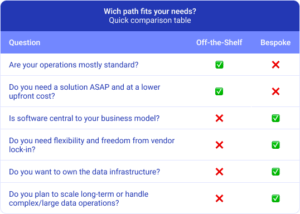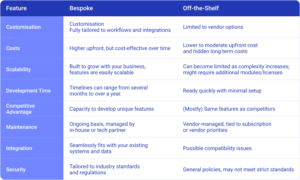One of the most pivotal decisions a growing business can make at a certain point in time is choosing between off-the-shelf software or developing its own solution or digital product.
It is not just a technical decision – it’s a strategic one that impacts budget, how the business aims to operate in the long run, and wants to be perceived (brand equity), which in certain cases can be a crucial solution to its operations and to remain competitive in a rapidly changing environment or industry.
In 2024, the global custom software development market size was estimated at USD 43.16 billion and projected to reach USD 146.18 billion by 2030, growing at a Compound Annual Growth Rate (CAGR) of 22.6% within the next five years. (Source Grand View Research, Inc. Custom Software Development Market Size, Share & Trends Analysis Report, 2025-2030).
There’s evidence that shows continued growth in this space, driven by businesses of all sizes choosing solutions tailored to their specific needs rather than reshaping its operations to generic tools. So, when and how do you know which path to take?
Let’s break it down into some insights.
Off-the-Shelf Software: Ready to Use, Simple to Adopt
Off-the-shelf software, often called “pre-built” software, is easy to implement and available immediately upon purchase or subscription. It has been tested in real-world environments and widely adopted, making it a safer option — especially when there’s no need to reinvent the wheel.
Notable examples include SaaS applications such as Salesforce (CRM), Mailchimp (email marketing), and Webflow (web design), all built to serve diverse business needs and a broad audience of users.
When Off-the-Shelf Makes Sense:
- Businesses that are just getting started and need something fast to complement their operations;
- Whether you are considering adopting an internal tool or framework, and your processes are fairly standard, a generic solution would work;
- Budget is limited;
- No need for deep customisations or integrations.
Bespoke Software: Built to Fit, Designed to Scale
A bespoke software is developed to match a business like a glove — addressing the specific requirements of a single organisation.
When bespoke makes sense:
- Your workflows, data structure, or compliance needs are unique;
- You want full control over security, performance, and integrations;
- You’re scaling and don’t want to be limited by rigid software or third parties;
- You need a long-term solution that evolves with your business.

When going bespoke can be your smartest move
Let’s face it, owning a digital product or software isn’t for every business, unless there’s a clear need and Return on Investment (ROI). However, when it’s the right fit, it can deliver value far beyond what off-the-shelf tools offer.
To put it in perspective: if your company manages sensitive information — medical records, financial details, or personal data — off-the-shelf software can leave you vulnerable. A bespoke system, on the other hand, lets you build security into the core architecture and gives you complete control over how and where your data is managed.
Also, if your team constantly builds spreadsheets just to compensate for what is missing from an off-the-shelf solution, it’s a clear sign you’ve outgrown your tools. Therefore, bespoke software or additional plug-in or customisation, when possible, allows to generate tailored workflows that match your requirements and automate internal processes, saving time and reducing errors.
In reality, most businesses don’t rely on a single system. They juggle CRMs, ERPs, IoT devices, data protection solutions, and AI tools. A bespoke application can serve as the unifying layer — organising data, powering automation, and integrating seamlessly with existing tools. The result: smooth data flow across departments, minimal disruption during system changes, and no more silos or duplicate entries.
Bespoke vs. Off-the-Shelf Software: Features Comparison

Final Thoughts
Opting between off-the-shelf and bespoke software is less about where your business is today and more about your strategic direction.
It’s a fact that bespoke software can be a smart investment, but it often comes with a higher initial price tag. It’s like commissioning a tailored suit. What you gain in return is precision, comfort, and confidence — something that genuinely fits your business, rather than forcing your business to fit the software.
The AI boom has undoubtedly shaped the software landscape, but it hasn’t removed the strategic considerations between off-the-shelf and bespoke solutions. Pre-built platforms with embedded AI features — such as chatbots, smart drafting or summarisation, and basic analytics for product (or content) recommendations — deliver great value for everyday business.
However, a bespoke app that integrates domain-specific AI models can provide a deeper alignment with a business architecture, data pipelines, and specific operational requirements.
In the end, this is a balancing act and there’s no one-size-fits-all answer — and that’s the point.
How LOAD can help you
If you are considering the shift toward bespoke software or developing your own digital product, LOAD can help you do it the right way.
We immerse ourselves in your business, and first start to understand what you or your clients aim (problem statement definition), what the potential users from the product (internal or external) expect, its needs (or pain-points) – having that in mind and based on user-centered design, we architecture a solution that is unique or at least solve a critical problem.
In essence, we foster innovation through detailed product development because we know every project and business has unique needs. We use the right technology to tackle them, not the other way around.
Chat with us and find out what we can unlock for your business!
















